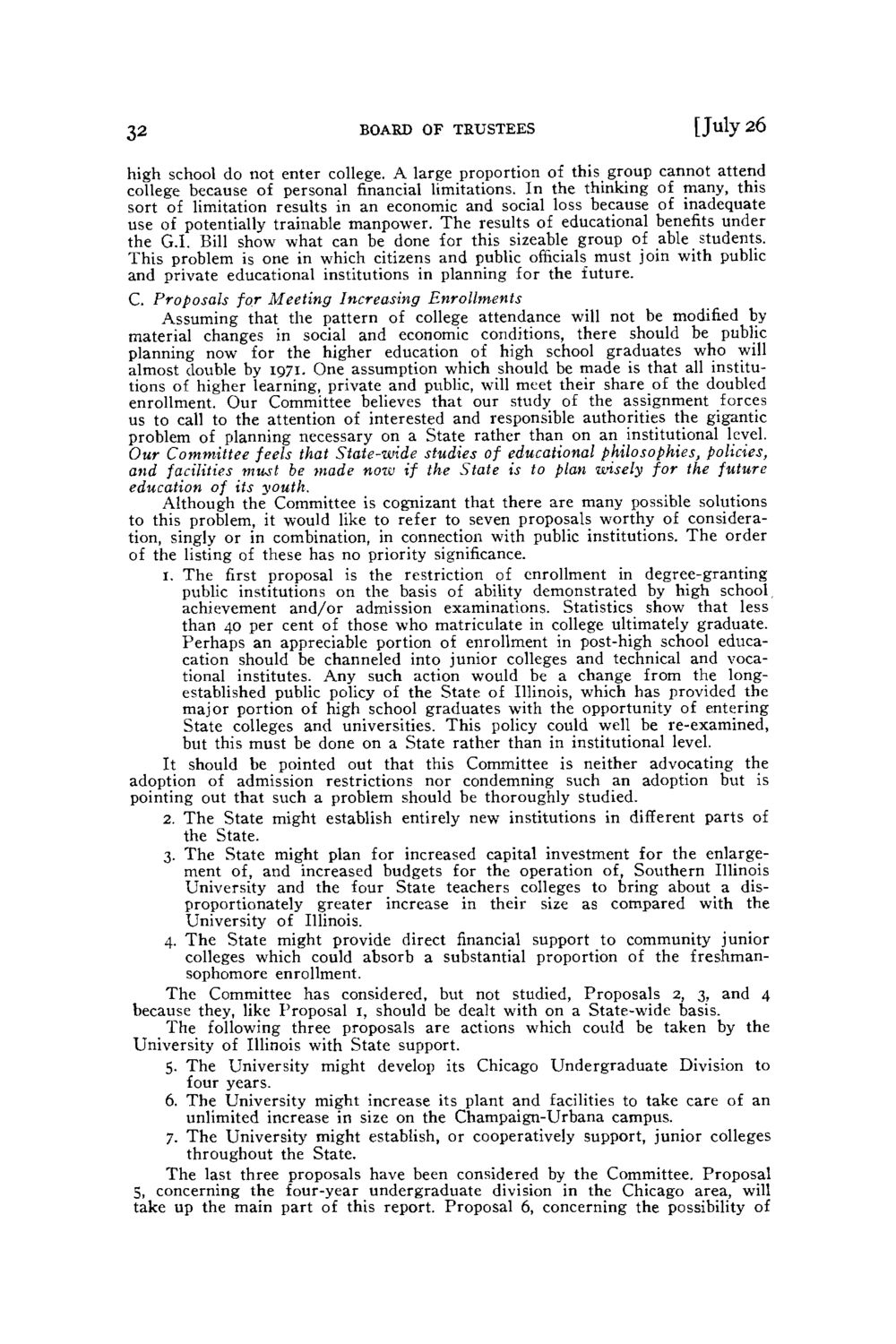| |
| |
Caption: Board of Trustees Minutes - 1956
This is a reduced-resolution page image for fast online browsing.

EXTRACTED TEXT FROM PAGE:
32 BOARD OF TRUSTEES [July 26 high school do not enter college. A large proportion of this group cannot attend college because of personal financial limitations. In the thinking of many, this sort of limitation results in an economic and social loss because of inadequate use of potentially trainable manpower. The results of educational benefits under the G.I. Bill show what can be done for this sizeable group of able students. This problem is one in which citizens and public officials must join with public and private educational institutions in planning for the future. C. Proposals for Meeting Increasing Enrollments Assuming that the pattern of college attendance will not be modified by material changes in social and economic conditions, there should be public planning now for the higher education of high school graduates who will almost double by 1071. One assumption which should be made is that all institutions of higher learning, private and public, will meet their share of the doubled enrollment. Our Committee believes that our study of the assignment forces us to call to the attention of interested and responsible authorities the gigantic problem of planning necessary on a State rather than on an institutional level. Our Committee feels that State-wide studies of educational philosophies, policies, and facilities must be made now if the State is to plan wisely for the future education of its youth. Although the Committee is cognizant that there are many possible solutions to this problem, it would like to refer to seven proposals worthy of consideration, singly or in combination, in connection with public institutions. T h e order of the listing of these has no priority significance. 1. The first proposal is the restriction of enrollment in degree-granting public institutions on the basis of ability demonstrated by high school, achievement a n d / o r admission examinations. Statistics show that less than 40 per cent of those who matriculate in college ultimately graduate. Perhaps an appreciable portion of enrollment in post-high school educacation should be channeled into junior colleges and technical and vocational institutes. Any such action would be a change from the longestablished public policy of the State of Illinois, which has provided the major portion of high school graduates with the opportunity of entering State colleges and universities. This policy could well be re-examined, but this must be done on a State rather than in institutional level. It should be pointed out that this Committee is neither advocating the adoption of admission restrictions nor condemning such an adoption but is pointing out that such a problem should be thoroughly studied. 2. The State might establish entirely new institutions in different parts of the State. 3. The State might plan for increased capital investment for the enlargement of, and increased budgets for the operation of, Southern Illinois University and the four State teachers colleges to bring about a disproportionately greater increase in their size as compared with the University of Illinois. 4. T h e State might provide direct financial support to community junior colleges which could absorb a substantial proportion of the freshmansophomore enrollment. The Committee has considered, but not studied, Proposals 2, 3, and 4 because they, like Proposal 1, should be dealt with on a State-wide basis. The following three proposals are actions which could be taken by the University of Illinois with State support. 5. The University might develop its Chicago Undergraduate Division to four years. 6. The University might increase its plant and facilities to take care of an unlimited increase in size on the Champaign-Urbana campus. 7. The University might establish, or cooperatively support, junior colleges throughout the State. The last three proposals have been considered by the Committee. Proposal 5, concerning the four-year undergraduate division in the Chicago area, will take up the main part of this report. Proposal 6, concerning the possibility of
| |